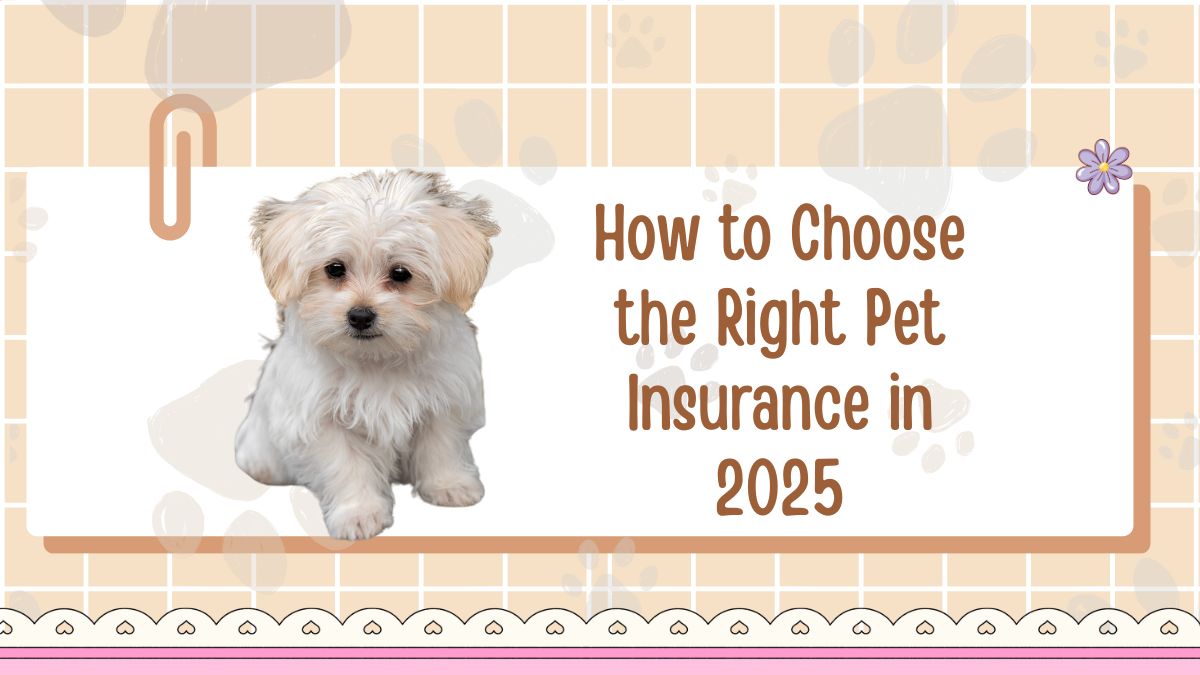As more of us consider our pets part of the family, the importance of pet insurance is growing rapidly. In 2025, the market for pet health coverage is stronger than ever, with new plan types, rising veterinary costs, and evolving owner expectations.
But with many options and complex policy terms, choosing the right pet insurance can feel overwhelming.
This article will walk you through everything you need to know — from industry statistics and cost benchmarks, to policy features, selection criteria, and tips for 2025. By the end you’ll have a clear roadmap to make the best decision for your furry friend.
Why Pet Insurance Matters in 2025
Here are compelling reasons why pet insurance so strongly deserves your attention this year:
- The average monthly cost for vet care is rising. In the U.S., the average premium in 2025 stands at about US $62.44 per month for dogs and US $32.21 for cats.
- Adoption of pet insurance is still relatively low but growing fast. Only a fraction of pet owners currently use it — yet growth rates of 20-30% year-over-year are reported.
- The global market is expanding rapidly: for example, one report values global pet insurance at USD 12.82 billion in 2025, with a projected CAGR of ~15.6% until 2032.
- The number of insured pets in North America also climbed: ~7.03 million pets were insured by end-2024, up ~12.2% from 2023.
- More employers and benefit-programs are adding pet insurance, as younger workers increasingly treat pets as family. For instance, one source notes 94 million U.S. households own at least one pet, up 15% in one year, and 51% of employees say pet insurance would influence job decisions.
All these factors mean that pet insurance is not just a luxury – it’s becoming a key tool for managing veterinary risks and protecting your pet’s wellbeing.
Key Facts & Figures at a Glance
Here is a handy table of current statistics and benchmarks for the pet insurance market in 2025:
| Metric | Value (2024-25) | Notes |
|---|---|---|
| Average U.S. monthly premium – dogs | ~US $62.44 | For dog policies in U.S. market. |
| Average U.S. monthly premium – cats | ~US $32.21 | For cat policies in U.S. market. |
| Number of insured pets in North America (end 2024) | ~7.03 million | Up ~12.2% from 2023. |
| Growth in U.S. insured pets (year 2023) | ~12.7% | Average growth rate ~20% since 2020. |
| Global pet insurance market size (2025 projected) | ~USD 12.82 billion | Global estimate for 2025. |
| U.S. pet insurance market size (2024) | ~USD 4.99 billion | U.S. market estimate. |
These figures highlight the scale of the market and its rapid growth. It also underlines why it’s crucial to make an informed decision.
What to Consider When Choosing Pet Insurance
When you’re sizing up options, there are several key criteria you should evaluate carefully.
1. Coverage Types
Different plans cover different types of risks. The most common types are:
- Accident & Illness: Covers both unexpected accidents (e.g., broken bones) and illnesses (e.g., chronic disease).
- Accident Only: Only covers accidents, not illnesses. Good for younger healthy pets but limited.
- Wellness / Preventive: Covers routine care such as vaccinations, dental checkups, parasite prevention. Some plans bundle this with the above.
2. Premiums, Deductibles & Coinsurance
- Premium is the monthly or annual cost you pay.
- Deductible is what you pay out-of-pocket before benefits kick in.
- Coinsurance means you pay a percentage of claims (for example 20%) after deductible.
You’ll want to compare these numbers across plans and see how they affect overall cost.
3. Waiting Periods & Exclusions
Most plans have waiting periods (e.g., for illness coverage) and exclusions (breed-specific conditions, pre-existing conditions, age limits). Understanding these is critical so you’re not caught with a claim denied.
4. Maximums & Limits
Some policies impose annual, lifetime or per-condition maximums. For example, a policy might limit coverage to US $5,000 per year or US $20,000 lifetime. Make sure the limits match what you might realistically need.
5. Claim Process & Reimbursement Method
Look at how the insurer handles claims (online submission, speed of payout), what percentage they reimburse (e.g., 70–90%), and how they pay (vet bills first then claim, or claim first). Good customer reviews and transparent process matter.
6. Age & Breed Considerations
Older pets or certain breeds with known health risks will often have higher premiums or exclusions. If your pet is already middle-aged or a breed prone to hereditary conditions, plan accordingly.
7. Geographic / Vet Network
Costs vary by region. Also check whether your preferred vet is accepted (or if you can go anywhere). Some plans may limit you to a network.
8. Optional Extras
These might include behavioural therapy, alternative treatments (acupuncture, hydrotherapy), or travel and boarding cover. Decide if you need these extras and how much extra they cost.
Step-by-Step Guide to Choosing the Right Plan
Here’s a practical roadmap you can follow:
- Estimate your pet’s risk profile: age, breed, health history.
- Set a budget: how much can you realistically afford monthly for a premium?
- Decide coverage level: Do you want full accident & illness + wellness, or just accident only?
- Compare multiple providers: Get quotes, compare premiums, deductibles, reimbursement rates, exclusions.
- Read the fine print: Particularly waiting periods, pre-existing conditions, lifetime caps.
- Check real-world feedback: How responsive is the insurer in real claims?
- Plan for growth: As veterinary medicine advances, costs will rise (and they already are).
- Review annually: Pet’s health changes, new treatments become available, and cover options improve.
Trends & Insights for 2025
To make a forward-looking decision, here are some of the major trends for 2025 you should keep in mind:
- Increasing vet costs: As veterinary diagnostics and treatments become more advanced, costs are climbing. For example, the average vet bill has increased by over 60% in the past decade in some markets.
- More customisation: Insurers are offering more tailored plans (e.g., pet age, breed, region) and wellness add-ons.
- Humanisation of pets: Owners view pets as family members and are more willing to pay for comprehensive care.
- Technology & InsurTech: Digital claim processing, apps, real-time vet bill submission, partnership with wellness monitoring for pets.
- Low penetration still: Even though growth is strong, only a modest percentage of pet owners currently have insurance – meaning opportunities (and competition) remain.
Table: Comparison of Sample Plan Features
Below is a hypothetical comparison table illustrating how two different pet insurance plans might stack up – illustrating how features vary. (Note: these are sample features only for guidance.)
| Feature | Plan A – Basic Accident Only | Plan B – Comprehensive Accident & Illness + Wellness |
|---|---|---|
| Monthly Premium | US $30 (cat) / US $55 (dog) | US $45 (cat) / US $80 (dog) |
| Deductible | US $300 annually | US $250 annually |
| Reimbursement rate | 70% of vet bill after deductible | 90% of vet bill after deductible |
| Coverage – Accident Only vs Illness | Only accidents | Accidents and illnesses plus wellness check‐ups |
| Waiting period (illness) | N/A | 14 days for illness; 0 days for accident |
| Annual/lifetime cap | US $5,000 / lifetime US $15,000 | US $15,000 / lifetime US $50,000 |
| Pre-existing condition exclusion | Yes, all excluded | Yes, but may cover after 12 months if symptom-free |
| Wellness cover | No | Yes: vaccinations, dental check-up, parasite prevention |
| Network of vets | Limited network | Any licensed vet in region |
Use such a table when comparing actual offers — tailor the categories to your local currency, your pet’s species/breed, region etc.
Special Considerations for Indian Pet Owners (or India & similar markets)
While much of the data above is U.S./global market oriented, if you are based in India (e.g., Haryana, Karnāl) or markets with similar dynamics, you should factor in:
- Local vet care costs: In India vet care costs are often lower than the U.S., but still rising and less widely insured.
- Availability of pet insurance: Ensure the insurer operates locally, has local claim process, accepts your vet.
- Understanding policy wording: Local insurers may still be developing sophisticated plans; check exclusions carefully.
- Currency & economic factors: Premiums might be in local rupees; consider inflation, currency risk, import of specialised treatments.
- Breed diversity: Local breeds may have different risk profiles compared to western breeds; find a plan that covers your specific pet type.
- Wellness culture: Routine preventive care is especially important — wellness add-ons may give extra value in markets where vet visits are less frequent.
Mistakes to Avoid
When shopping for pet insurance, avoid these common mis-steps:
- Choosing only the lowest premium without checking coverage limits or reimbursements.
- Assuming all conditions are covered — many plans exclude pre-existing conditions or hereditary disorders.
- Ignoring waiting periods — you may sign up only to find coverage doesn’t apply for several months.
- Failing to check maximums — even full coverage can run out if lifetime caps are low.
- Not reviewing the policy annually — your pet’s health status and needs evolve.
- Overlooking the claim process — delayed reimbursements or complex documentation can mean you end up paying up-front a lot.
- Buying a plan once and forgetting — new plan types and better options appear regularly.
Choosing the right pet insurance in 2025 means being informed, proactive, and realistic. Understand your pet’s needs, your budget, and the features that matter most — coverage type, exclusions, caps, claims process.
With rising vet costs, increasing pet-ownership, and greater market maturity, selecting a good plan now can make a big difference down the line. Don’t wait until you’re facing a large vet bill — insurance is about preparation.
By comparing plans carefully, reading the fine print, and choosing a reputable insurer, you’ll give your beloved pet the protection and care they deserve — and give yourself the peace of mind that you’re prepared for whatever comes.
FAQs
It’s best to purchase a policy early, ideally when your pet is young and healthy. This generally means lower premiums, fewer pre-existing conditions, and fewer exclusions. As pets age, premiums tend to rise and more conditions may be excluded.
Some plans include wellness or preventive care add-ons (vaccinations, dental check-ups, parasite prevention). Standard accident/illness plans often do not include these unless you pay extra for a wellness package. (See comparison in the table above.)
Generally no — most insurers exclude pre-existing conditions (illnesses or symptoms that occurred before policy inception). Some insurers may cover such conditions if the pet remains symptom-free for a defined waiting period (e.g., 12 months) and then a new policy is purchased. Always check the policy wording.




